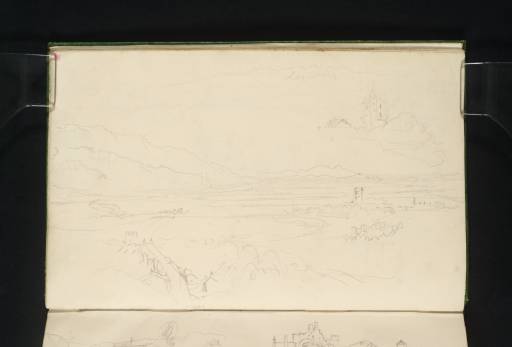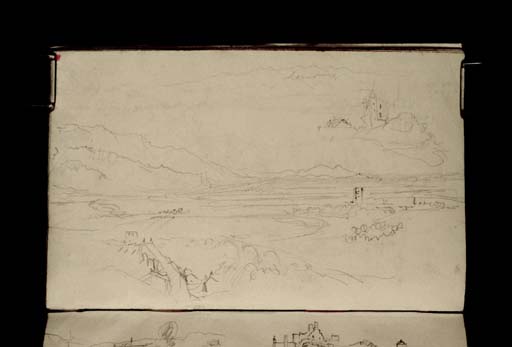Joseph Mallord William Turner Carse of Stirling with Cambuskenneth Abbey and the Old and New Bridges 1831 and 1834
Image 1 of 2
Joseph Mallord William Turner,
Carse of Stirling with Cambuskenneth Abbey and the Old and New Bridges
1831 and 1834
Joseph Mallord William Turner 1775–1851
Folio 15 Verso:
Carse of Stirling with Cambuskenneth Abbey and the Old and New Bridges 1831 and 1834
D26465
Turner Bequest CCLXX 15a
Turner Bequest CCLXX 15a
Pencil on white wove paper, 125 x 201 mm
Inscribed in pencil by Turner ?‘Lenring’ top
Inscribed in pencil by Turner ?‘Lenring’ top
Accepted by the nation as part of the Turner Bequest 1856
References
1909
A.J. Finberg, A Complete Inventory of the Drawings of the Turner Bequest, London 1909, vol.II, p.868, CCLXX 15a, as ‘Plain, with mountains.’.
1936
Henry J. Crawford, Turner’s Sketches and Drawings of Stirling and Neighbourhood With Some Notes on the Artist’s Scottish Tours also A Note on John Ruskin and Stirling, Stirling 1936, p.
reproduced between pp.22–3, p.24.
1990
David Wallace-Hadrill and Janet Carolan, ‘Turner’s Sketches North of Stirling’, Turner Studies, Summer 1990, vol.10 no.1, p.17.
This view of the Carse of Stirling from Gowan Hill raises the possibility that Turner used the Stirling and West sketchbook on two visits to Stirling in 1831 and 1834. Henry Crawford was the first to point out that the sketch includes Stirling’s New Bridge, the foundation stone of which was laid in September 1831.1 The bridge was not completed until 1833, leading David Wallace-Hadrill and Janet Carolan to ask, ‘Is there a possibility that this sketch belongs to Turner’s 1834 tour rather than that of the Summer of 1831?’2 Another sketch on folio 10 verso (D26455) may also include some the arches of the New Bridge, and both bridges were included in Turner’s watercolour of Stirling circa 1834–5 (Glasgow Museums).3
There are two possible explanations. The first, raised by Crawford and Wallace-Hadrill and Carolan, is that Turner used the Stirling and West sketchbook on two occasions. First in 1831 and again on his return in 1834, when he filled in blank pages with new sketches of Stirling next to the old ones in order to keep his source material together in one place. Alternatively, he could have made this sketch in 1831, adding the New Bridge in late 1834 after seeing it on his return to the town. This second explanation is perhaps more convincing as the sketch opposite on folio 16 (D26266), which must have been made before the smaller flanking sketches of Loch Fyne on the same page, depicts a view from nearby that was presumably made on the same occasion. It also seems unlikely that Turner would have brought the very full Stirling and West sketchbook back with him to Scotland in 1834 just to make one or two sketches.
The view is over the Carse of Stirling, an area of flat, low-lying agricultural land to the west of town with the River Forth in the middle distance. It was made from Gowan Hill near Stirling Castle and includes, as mentioned, the two bridges over the River Forth in the foreground. At the right is Cambuskenneth Abbey, which is also drawn in more detail in a separate sketch above. To the left is the hill of Abbey Craig with the Ochil Hills behind it.
Across the top of the page is a separate sketch of the outline of hills. This is inscribed with what Wallace-Hadrill and Carolan have read as the word ‘Lenring’, referring, they suggest, to Lanrick, which lies to the north-west of Doune, about nine miles north-west of Stirling.4 Crawford argued that this sketch, along with the outline of hills below (which he suggested was separate from the main sketch) depicts ‘the Cobbler group [Ben Arthur], Ben Venue, the Menteith Hills, Ben Anna and Ben Ledi (all almost perfect), as seen from Stirling.’5
For references to further sketches of Stirling, see folio 13 (D26460).
Thomas Ardill
June 2010
How to cite
Thomas Ardill, ‘Carse of Stirling with Cambuskenneth Abbey and the Old and New Bridges 1831 and 1834 by Joseph Mallord William Turner’, catalogue entry, June 2010, in David Blayney Brown (ed.), J.M.W. Turner: Sketchbooks, Drawings and Watercolours, Tate Research Publication, December 2012, https://www


